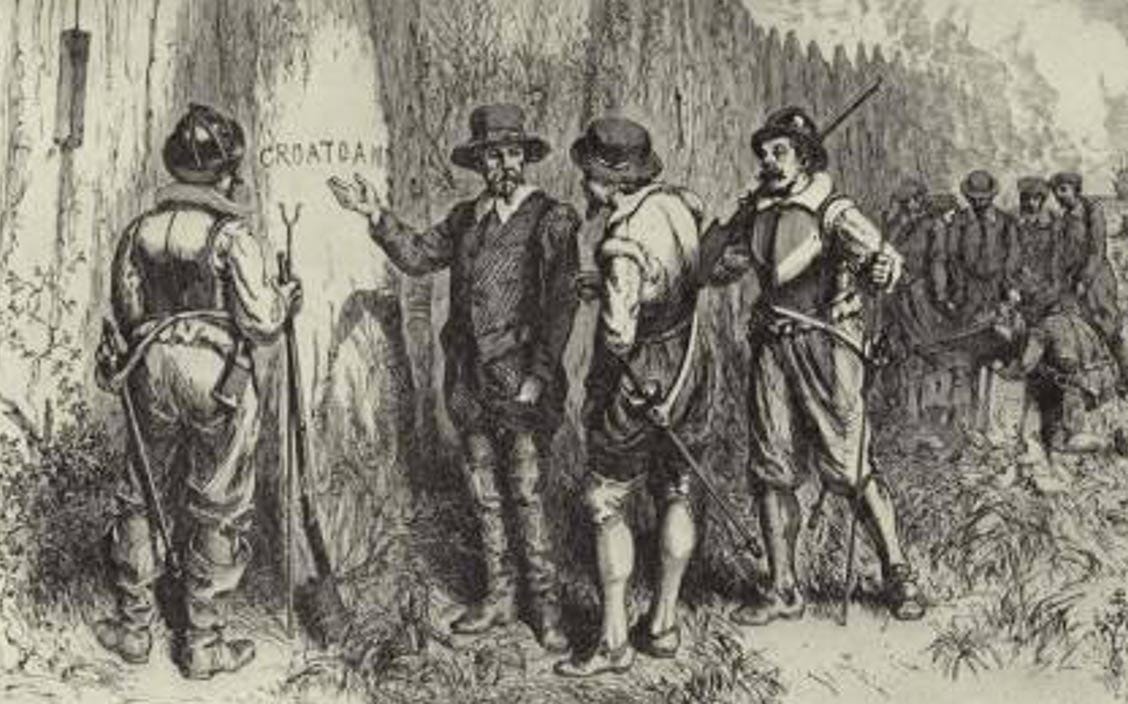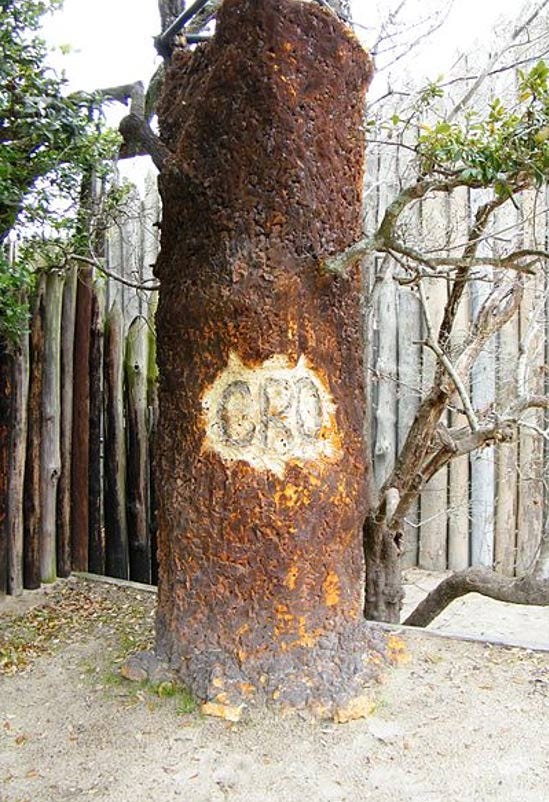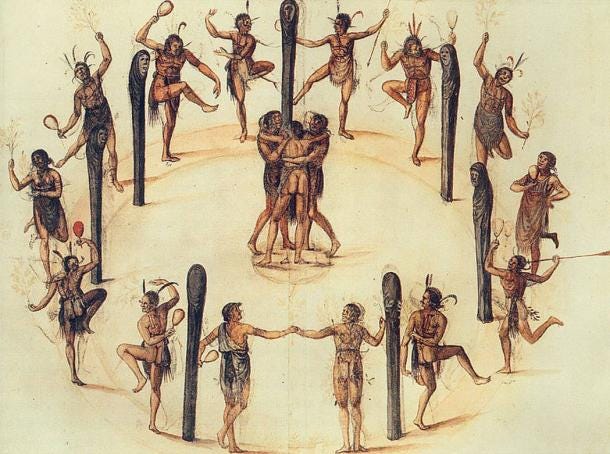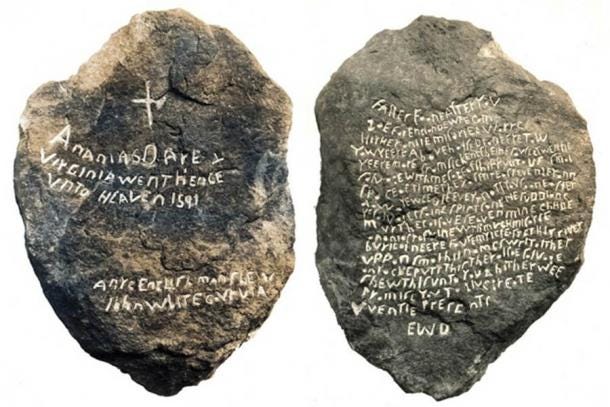What Happened to the Lost Colony of Roanoke Island?
The early English settlers of Roanoke Island in the New World established homes and lives alongside indigenous populations, but then they vanished completely, only leaving behind a coded message for other colonists. If there were survivors of the mysterious events of their disappearance, where did they go? What was the fate of the vanished Roanoke Island colony?
Hardships for the Roanoke Island Colony
In 1584, the English attempted to set up a colony in the New World on Roanoke Island, North Carolina. The following year, the colony was abandoned due to the harsh weather, lack of supplies, and poor relations with the indigenous people. Three years later, a second attempt at colonization was undertaken. As the struggles to survive and thrive continued, one of the settlers, Captain John White, was forced to return to England to obtain supplies.
The village of Secoton in Roanoke, painted by settler and artist Governor John White c.1585. ( Public Domain )
In 1587, White’s daughter gave birth to Virginia Dare, who was said to be the first English child born in the New World.
Leaving behind friends and family, White sailed to England against his will. He remained there three years, as the Queen had disallowed all shipping due to Spanish Armada attacks on England.
Vanished!
When he finally returned in 1590, the Roanoke Island colony had vanished , and it is said that White found only the words ‘CRO’ and ‘CROATOAN’ carved on two trees.
"CRO" written on a tree, part of the Lost Colony performance at Fort Raleigh National Historic Site. (Sarah Stierch/ CC BY 4.0 )
When White saw these words, he inferred that the settlers had sought the help of the Croatan Indians on the nearby Hatteras Island. It had previously been decided by the settlers that should they move due to disaster or attack a Maltese Cross image would be left behind. No such symbol was found by White.
Mystery enshrouds ancient Native Americans who built burial mounds
The Controversial Origins of the Maine Penny, A Norse Coin found in a Native American Settlement
Do Spirit Pond Inscriptions show that the Holy Grail was taken to North America?
Did the Lost Roanoke Island Colonists Join the Croatans?
The Croatans had been friendly towards the settlers, as the English were able to establish good relations with them when they founded their colony in 1587. Thus, it was reasonable to speculate that the colonists had gone to Hatteras Island during White’s absence. Dogged by terrible weather and a dangerously reluctant sailing crew, White was unable investigate the matter further.
He went back to England instead, leaving behind the mysterious disappearance of the colony, his daughter, and granddaughter. He never returned to the New World. Consequently, no one is certain of the fate that befell the English settlers of Roanoke Island.
One of the theories regarding the disappearance of the English Roanoke Island colony is that they managed to integrate themselves with the Croatan people. It has been claimed that subsequent English historians mentioned a tribe of North Carolina Indians who spoke English fluently, practiced Christianity, and called themselves Croatan Indians. Additionally, there were between 20 and 30 English surnames from the Roanoke settlers found in the Croatan tribe, suggesting that integration between the two peoples had happened.
Dancing Secotan Indians in North Carolina. Watercolor painted by explorer and artist John White in 1585. ( Public Domain )
More recently, the Lost Colony Center for Science and Research has initiated the ‘Lost Colony DNA Project’ to investigate whether the Roanoke settlers did assimilate themselves with the Croatans.
Archaeological excavations on the remains of an Indian village at Cape Creek and Pamlico Sound near Cape Hatteras recovered not only artifacts produced by the Indians, but also European trade goods. While this demonstrates that the Croatans were likely to have had contact with the Roanoke settlers, it is not enough to say that the two peoples were assimilated.
The Croatans themselves were believed to have become extinct by the early 17th century. Their direct descendants, the Lumbee (who still exist today), began appearing some 50 years after the disappearance of the Roanoke settlers. One of the prominent characteristics of the Lumbee people, as pointed out by observers, is their European features. By 1650, the Lumbee had migrated and settled in Robeson County.
Although the intermarriage between the Croatans and English settlers is the most popular explanation for the origins of the Lumbee, it is not accepted by all. For instance, some subscribe to the ‘Cherokee Theory’, in which some of the Cherokees marching home after fighting the Tuscarora (in the early 18th century) with Colonel John Barnwell decided to remain in Robeson County and intermarried with local residents. Amongst the Lumbee it has been reported that their oral tradition contains four different migration theories.
The Mysterious Dare Stone, Is it a Hoax or the Last Message of a Lost Daughter?
Even though many believe that the colonists joined the Croatans and eventually became the Lumbees, some believe that a darker fate befell the settlers. The Dare Stone, discovered in the 20th century, records that the number of settlers dwindled to 24 as a result of illness and war with hostile natives. In the end, only seven of the original settlers were left.
One of them was Eleanor White Dare, the daughter of Captain John White and the alleged maker of the stone. It has been claimed, however, that the Dare Stone is a hoax. Moreover, archaeological evidence has yet to prove that the settlers slowly perished, as no burials have been found so far.
Nonetheless, researchers have recently decided to take another look at the Dare Stone . It was originally disregarded because of other hoax stones having appeared soon after it was found, but a re-examination shows that it is different from the other (proven) fakes. The writing was made by a different hand and the words are more likely to have appeared in the proper time frame (no obvious modern words are included).
Front and back of the original Dare Stone. ( Brenau University )
Ed Schrader, a geologist and president of Brenau University in Georgia, where the Dare Stone is kept, seems hesitantly hopeful about the results of the new analysis. He says , "If this stone is real, it's the most significant artifact in American history of early European settlement. And if it's not, it's one of the most magnificent forgeries of all time."
Schrader went on to say that Dare was "moderately educated" and the wife of a stonemason, so she probably had the skills necessary to create the inscription. However, before Schrader pushes for an expensive and "exhaustive, geochemical investigation," he’s requested a Brenau professor to assemble a team of linguists to give the language on the stone a more thorough analysis.
Other theories about what happened to the Roanoke colony suggest cannibalism by local tribes to account for the lack of human remains, or that the settlers perished at sea while trying to return to England.
Skeleton found at shipwreck site is a reminder of a brutal massacre off the Australian coast
First colonists led by Christopher Columbus hit by severe scurvy
Recent Discoveries Linked to the Lost Roanoke Colony
In 2020 two different theories related to the Roanoke Colony mystery made headlines. The first comes from Scott Dawson, a native of Hatteras Island and an amateur archaeologist who’s spent more than a decade excavating a site be believes is connected to the colony’s mysterious disappearance.
The researcher has found beads, tools, and Native American arrowheads along with artifacts which have been linked to the English settlers. Dawson believes that these are evidence of a “survivors camp,” where most of the colonists moved and integrated with the Croatoan tribe following the original colony’s abandonment and “massive political eruptions and disagreements.” The “survivor's camp” on Hatteras Island is thought to have been an ideal camping spot for the ousted colonists to wait for the vessel returning from England. It’s believed that the separatists eventually integrated with the local tribe - supporting the popular belief of what happened.
The second study released in 2020 related to the lost Roanoke colony suggests that survivors lived among native populations in what’s now Bertie County, North Carolina. According to a press release from the First Colony Foundation, “English pottery pieces that date from the 1580s including jugs and pots used for food preparation, consumption and storage, have been discovered in Bertie County.” The researchers claim the artifacts indicate there was a long-term habitation of the Roanoke survivors at the site.
Phil Evans, president of the First Colony Foundation, believes these artifacts show at least one family from the lost colony of Roanoke “lived there, and possibly some servants.” The artifacts include a “Martincamp flask and a Spanish olive jar,” which are said to be similar to pottery found at the Fort Raleigh Historic Site on Roanoke Island, and to items found at the Jamestown colony site. However, as Ashley Cowie writes, “established Roanoke experts have strongly questioned the new findings related to this latest Roanoke colony theory.”
Top image: Illustration depicting Captain John White returning to Roanoke Island and discovering the word “CROATOAN” carved into a tree at the fort palisade. Source: The Commons






Artifacts found in historically native areas doesn't mean the English and natives integrated. The natives could have traded for these goods, or taken these goods and used them without living with the English.
While recent discoveries that are massively unique about Oak Island Nova Scotia, there is coming proofs that English (Italian) discoverer John Cabot of Nova Scotia and the Canadian Maritimes in 1498, it was shortly thereafter in the early 1500s-mid 1500s, that British/Scottish colonists came to Oak Island, settled, occupied, and created such craft and base-industrial island complex. This would be at the same time or even earlier (with a sheltered environment in Mahone Bay), that such sailing and fishing fleets from this area could have had (and maintained) contact with the Roanoke colony(s) ... and they could have recovered them back to Oak Island in both instances - while there would be some that would assimilate into the Croatan peoples.
One needs to have the Lumbee tribe to do their DNA picture, and these studies would provide greater analysis of the Lumbee and their further Cherokee assimilations as well.